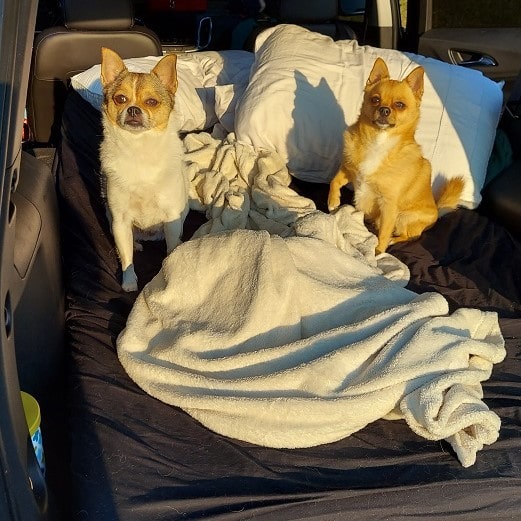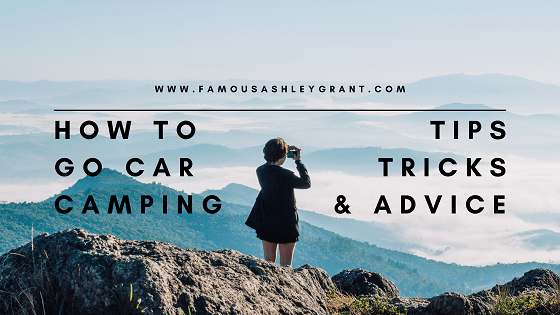Want to learn how to go car camping? Perfect! In this post, I’m sharing some tips and advice for doing just that.
Ideas for How to Go Car Camping
The open road is calling your name! There’s no better way to experience the freedom of the great outdoors than by going car camping. Whether you’re a seasoned road tripper or new to spending nights under the stars, it’s time to pack up your car, grab your pups (or kids) and partner and hit the road.
In this post, I’ll give you my top tips and tricks for how to go car camping like a pro. From choosing the best car camping gear to planning your ultimate camp cooking set-up, I’ve got all the information you need to make your car camping trips easy, affordable, and so much fun.
Get ready to soak in epic sunsets, gaze up at starry night skies, and create lifelong memories on your car camping adventures. Let’s hit the road!
Choosing a Car for Car Camping
When it comes to choosing a car for car camping, you’ll want to consider cargo space, gas mileage, ground clearance, and more. For my car camping trips, I’ve chosen to use my 2018 Chevy Equinox. This mid-size SUV has plenty of cargo volume with 63.9 cubic feet of space when the rear seats are folded down. The Equinox also gets decent gas mileage, averaging about 26 mpg combined city/highway. The 7.9 inches of ground clearance helps me navigate dirt roads leading to campsites too.
I’ve test driven my Equinox fully loaded with my tent, sleeping bags, cooler, and other gear to make sure everything fits nicely. If you’re borrowing or renting a car for camping, be sure to test out your set-up at home first before heading out on the road.
Car Camping Gear Essentials
Here are some of the key car camping gear essentials you might want to bring along:
– Tent – You might want to use a 5-person dome tent that packs down pretty small. Rooftop tents and attachable tent add-ons are also great options.
– Sleeping pads and sleeping bags rated for the expected weather. Don’t forget pillows!
– Camp kitchen supplies like a portable propane stove, pots/pans, utensils, plates, and cups.
– Headlamps or lanterns for lighting. Folding camp chairs and a rug for the site.
– Clothing layers and hiking shoes – be prepared for changing temps.
– First aid kit, fire extinguisher, bug spray, sunscreen
We Actually Slept in the Car In Lieu of Bringing a Tent

One of the best aspects of car camping is being able to sleep in your vehicle rather than pitch a tent. Here are some tips for getting good sleep:
– Measure your car’s interior dimensions and get a mattress that fits perfectly once the seats are folded down. Memory foam mattresses are ideal for comfort.
– Completely clear out the car and organize gear so you have maximal sleeping space. Consider adding window shades for privacy.
– Bring battery-operated fans or ventilation systems if it will be hot. In cold weather, use sleeping bags rated for low temps.
– To sleep level, place wooden blocks under the tires or inflatable camping pads under the mattress.
– Use curtains to block outside light and keep the car cool in sunny weather.
– Keep basic supplies like water, headlamp, and snacks within reach overnight.
– Park strategically – not directly under trees or too close to shrubs to avoid nature run-ins.
With a few modifications, you can transform your car into a cozy bedroom on wheels for peaceful camping nights! Sleeping in the car makes car camping even more convenient.
Meal Planning and Preparation Tips
– Make a menu in advance and prep ingredients/supplies at home before your trip. Non-perishable foods are ideal.
– Pack a high-quality cooler with ice and resealable containers for dairy, meats, produce.
– A portable propane camp stove makes cooking meals easy. You can also grill on a fire pit.
– Plan for simple camp meals like sandwiches, breakfast burritos, foil packet dinners. And snacks!
– Consider no-cook meal options too like wraps, salads, and fruits.
– Practice good food safety and hygiene, and cook meat thoroughly.
Finding Great Car Camping Locations
– Research national or state parks with campgrounds that allow car camping. Many are beautiful and affordable.
– Consider free dispersed camping on Bureau of Land Management or National Forest land.
– Use camping apps like The Dyrt or Campendium to find location reviews and amenities.
– Factor in things like restrooms, showers, hiking trails depending on your needs.
Setting Up Your Car Campsite
– Scout the site while there’s daylight and situate your vehicle appropriately.
– Set up sleeping tents, kitchen area, camp chairs in a logical way in relation to your car.
– Use a shade canopy or tarp for eating and hanging out area.
– Practice food storage safety – stow food away from the tent area overnight.
– Have emergency items like a first aid kit, flashlight, and fire extinguisher handy. Be fire safe.
Tools and Apps for How to Go Car Camping
Here are some helpful tools and apps to have on hand if you plan to go car camping across the United States:
– GPS Navigation Apps – Apps like Google Maps, Waze, Apple Maps to help plan routes and navigate to campsites. Download maps offline.
– Camping Apps – The Dyrt, Campendium etc to find campsites and read reviews. ReserveAmerica for reservations.
– Roadside Assistance – AAA membership or roadside help through your insurance provider in case of car issues.
– GasBuddy App – Find cheap gas stations along your route.
– Repair Tools – Spare tire, jack, tire pressure gauge, jumper cables, basic toolkit, duct tape.
– Utility Apps – Flashlight apps, compass app, weather radar app. First aid app.
– Charging Cords – Bring extra chargers and battery packs to keep devices powered.
– Emergency Communication – Satellite messenger, emergency beacon, or portable satellite device if in remote areas.
– Camp Cooking Aids – Apps with camp recipes and cooking tips. Campsite cooking gear.
– National Park Apps – For info, maps, alerts and hiking tips when visiting parks.
Being prepared with handy apps and tools will give you more confidence and freedom when embarking on a US car camping road trip!
Do’s and Don’ts for Car Camping
DO:
– Research camping regulations for where you plan to camp. Obtain permits if needed.
– Pack adequate food, water, first aid, and gear to be self-sufficient.
– Follow Leave No Trace principles – take trash with you, don’t damage vegetation.
– Extinguish fires completely before leaving a site.
– Keep food stored securely when not in use to avoid animal encounters.
– Choose established campsites whenever possible to minimize impact.
– Be considerate of noise, keep music low in shared camp areas.
DON’T:
– Don’t leave food out overnight – store securely in the car or bear-proof container.
– Don’t wait until after dark to pick a spot to camp or set up.
– Don’t camp too close to cliff edges, rivers, streams or on an uneven surface.
– Don’t leave trash behind or bury trash. Pack it out.
– Don’t cut down branches or damage vegetation to make a fire pit.
– Don’t feed or interact with wildlife – observe from a distance.
Following car camping do’s and don’ts helps protect the outdoors and your safety.
Tricks and Tips for Car Camping
Here are some handy tricks and tips for car camping:
– Use binder clips to secure towels, lanterns, etc to your car doors or tents.
– Store camp cooking tools like spatulas and tongs in old socks so they’re easy to find and pack.
– Freeze gallons of water to use as ice packs in your cooler – they last longer than just ice.
– Bring a cheap solar shower or utility shower to hang outside for a warm camp shower.
– Use magnetic hooks inside your car to hang and organize small items.
– Pack a multi-use piece of equipment like a camp shovel that can also chop or cut.
– Keep food storage simple with Ursack bear bags to hang food at night.
– Use a plastic tablecloth on picnic tables to keep clean and dry.
– Attach glow sticks to tent zippers to see at night. Use headlamp on red light mode.
– Pack clothespins to hang wet clothes or towels to dry at your site.
Ready to Go Car Camping?
Hitting the open road for a car camping adventure allows you to fully immerse yourself in the great outdoors. With the right gear, supplies, and camp location, you’ll be on your way to making lasting memories under the stars in no time.
Start by choosing a roomy, fuel-efficient vehicle like an SUV or minivan to transport you and all your camping necessities. Outfit your car with a foldable mattress that fits perfectly after laying the seats down, as well as your sleeping bags, pillows, and linens.
Pack your camp kitchen, safety equipment, and plenty of snacks. Meal prep and plan easy camp cooking menus before you go. The best part about sleeping in your car is avoiding the hassle of setting up a tent!
Use helpful camping apps and maps to pinpoint amazing car camping destinations near national parks, forests, and public lands. When you arrive, scout the perfect campsite spot and set up your foldable chairs, camp kitchen, and shade canopy.
Above all, embark on your car camping trips with a sense of adventure and wonder. Bond with your companions, unplug from technology, and revel in the beauty of nature. You’ll be so glad you took the time to hit the open road and enjoy a simpler way of life.
Let the car camping begin!







Car camping is such a fantastic way to connect with nature while still having the comforts of home nearby. Thanks for sharing these helpful planning tips!